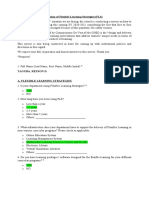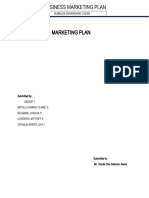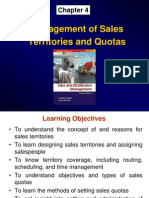Research
Research
Uploaded by
Adil AhmedCopyright:
Available Formats
Research
Research
Uploaded by
Adil AhmedCopyright
Available Formats
Share this document
Did you find this document useful?
Is this content inappropriate?
Copyright:
Available Formats
Research
Research
Uploaded by
Adil AhmedCopyright:
Available Formats
RESEARCH STUDY AND ANALYSIS
A. RESEARCH DESIGN
For this study, a quantitative approach was followed. Leedy and Ormond (2001:191) define descriptive quantitative research as the identification of characteristics of observed phenomenon. The research methodology used to solve the main problem included a literature study, a survey, secondary data and an empirical study.
A.a. Literature study
The literature study was conducted with the purpose of identifying best practices for the recruitment and selection process.
A.b. Secondary data
Secondary data in this study included data on employees turnover in the last three years as well as udaivilas policy on recruitment and selection.
B. EMPIRICAL STUDY
The empirical study was done by means of a questionnaire which was mailed to respondents.
B.a. Mail survey
A sample survey, administered via face to face, was conducted among employees and hr emplyoees. The questionnaire examined the effectiveness of the assessment tools as perceived and utilised by these managers. The study was focused on first HR specialist, as they were responsible for the recruitment and selection of fresh employees in udaivilas.
B.b. Measuring instrument
A questionnaire was developed by the researcher and used as a measuring instrument in this study.
C. Sample
The sample consisted of sixteen emplyoees at udaivilas, who were responsible for two hundred employees. The questionnaire was get filled by employees as well as HR seniors. The HR manager printed the questionnaires and completed them. Some respondents preferred to respond on the computer system.
D. Statistical analysis of data.
The statistical analysis of the data was mainly done by computing the percentages obtained for various questions and by presenting these by means of tables and bar graphs.
RESEARCH DESIGN AND METHODOLOGY INTRODUCTION
In Chapter two a literature study on recruitment and selection was presented. Various aspects of the recruitment and selection processes were discussed. Old Mutuals recruitment and selection policy was discussed in terms of the guidelines set out by various authors. It was clear that the policy used by Old Mutual for recruitment and selection does meet the relevant requirements as indicated by various authors. This chapter describes the research methodology used for this study. The aim of the study was to assess the recruitment and selection strategies used by Old Mutual Group Schemes (OMGS) in udaivilas. A thorough methodological foundation directs the whole dissertation with respect to its planning, organisation, presentation, analysing and interpretation of data thereby enhancing the validity and reliability of all recommendations and conclusions made from this research. According to Saunders, Lewis and Thornhill, research methodology assists the researcher in deriving clear objectives from the research questions, specifying the source from which data is to be collected and considering the constraints of the study, which the researcher will inevitably have. The research question, as well as the objectives of this study, was discussed in Chapter one. In this chapter, attention is given to the research strategy/design, population and sample, data collection method, questionnaire design and layout, pilot study, validity and reliability and response rate.
RESEARCH STRATEGY/ RESEARCH DESIGN
The research strategy is a general plan of how the research question that has been identified will be answered. The research strategy should contain clear objectives derived from the research questions, specify the sources from which data are to be collected and consider the constraints. Three main research strategies identified by Saunders etc all include the survey, case study and experiment. As the survey strategy was utilised for this study, it will be discussed in more detail.
Survey
The survey method is usually associated with a deductive approach. Surveys allow the collection of a large amount of data from a sizeable population in a highly economical way. Much time is spent on designing and piloting a questionnaire and in analysing the results. For purposes of this study, a questionnaire was designed as a data collection tool. A questionnaire is suitable when information, related to opinions, attitudes and behaviours, have to be collected. Experiments and case studies are less suited for the collection of opinions and attitudes, and interviews are very time consuming and difficult to
analyse if the researcher is not very experienced. In this chapter, the research methodology used in this study was discussed. A survey was conducted in which a questionnaire was used as the measuring instrument. The questionnaire was carefully design to meet scientific requirements and was subjected to a pilot study. Responses were received from thirteen of the sixteen managers targeted for the study. In Chapter four the results of the empirical survey are presented and analysed.
DATA COLLECTION METHODS
The most common types of data collection methods are interviews, observation and questionnaires. Due to the disparity of the population/sample, it was not feasible to select interviews or observation as a data collecting method. As stated earlier, the data collection method used for this study was the questionnaire.
QUESTIONNAIRE
Questionnaire design and layout are important aspects of a questionnaire. They assist in capturing the interest of the respondents and obtaining the relevant information. In this study, the questionnaire was designed with keeping the target group, that is, sales managers at Old Mutual who are responsible for the recruitment and selection of sales consultants, in mind.
You might also like
- B. Form 2.2 Research Summary SheetDocument5 pagesB. Form 2.2 Research Summary SheetCristoper Bodiongan100% (1)
- Demonstration DLLDocument2 pagesDemonstration DLLJanet G100% (2)
- Bbc2 MGT 102-HboDocument5 pagesBbc2 MGT 102-HboRhodora Esteves MalicdemNo ratings yet
- Questionnaire: Kindly Fill The Following: (Please Put A Tick Mark in The Appropriate Box)Document2 pagesQuestionnaire: Kindly Fill The Following: (Please Put A Tick Mark in The Appropriate Box)ABILAH SALUMNo ratings yet
- Doyuhim NSTP CWTS 102 Chapter 1 3 ActivitiesDocument14 pagesDoyuhim NSTP CWTS 102 Chapter 1 3 ActivitiesShamel LopezNo ratings yet
- The Development of Tourism in Dumaguete City Before and After The Pandemic-1Document12 pagesThe Development of Tourism in Dumaguete City Before and After The Pandemic-1Winston VillegasNo ratings yet
- Sample Research GapDocument2 pagesSample Research GapKenjave Mark T. ParleroNo ratings yet
- Module 1Document2 pagesModule 1Amethyst LeeNo ratings yet
- Letter To The Research Adviser and PanelDocument3 pagesLetter To The Research Adviser and PanelShermay Dela Serna GranitoNo ratings yet
- Chapter IIIDocument23 pagesChapter IIIilham0% (1)
- 4TH PT1 MethodologyDocument7 pages4TH PT1 MethodologyKirito - kunNo ratings yet
- Ai Results Interpretation and Discussion 1Document9 pagesAi Results Interpretation and Discussion 1DEVERLYN SAQUIDONo ratings yet
- Ms. Medelyn Salcedo Lacunsay, RC., Mscrim. InstructorDocument144 pagesMs. Medelyn Salcedo Lacunsay, RC., Mscrim. InstructorEmelita Valdez LealNo ratings yet
- Thc2: Risk Management As Applied To Safety, Sanitation and Security Bshm-IDocument5 pagesThc2: Risk Management As Applied To Safety, Sanitation and Security Bshm-ISheena HarrienNo ratings yet
- 2018 RSET Davao RegionDocument461 pages2018 RSET Davao Regionemmanuel CabigasNo ratings yet
- Appendix 2 Biographical Statement of Maria Roxanna L. FacundoDocument2 pagesAppendix 2 Biographical Statement of Maria Roxanna L. FacundoLyka hinampasNo ratings yet
- g7 Research PaperDocument31 pagesg7 Research PaperSHAMNo ratings yet
- Motion Activated Temperature Controlled Matc Electric FanDocument5 pagesMotion Activated Temperature Controlled Matc Electric FanBuena QuintinNo ratings yet
- Social Experiment AssignmentDocument2 pagesSocial Experiment AssignmentedadsetanNo ratings yet
- Online Learning and Learning Interest Among UM Freshmen Engineering StudentsDocument32 pagesOnline Learning and Learning Interest Among UM Freshmen Engineering StudentsTimothy James Almasa100% (1)
- SHS Thesis Writing Chapter 2 - Review of Related LiteratureDocument9 pagesSHS Thesis Writing Chapter 2 - Review of Related LiteratureLizette CondeNo ratings yet
- CNNHS (Survey and Interview) LetterDocument1 pageCNNHS (Survey and Interview) LetterPrincess Anne ChavezNo ratings yet
- Cawagas Pedagogical Principles PP 299-306Document8 pagesCawagas Pedagogical Principles PP 299-306María Julia SolovitasNo ratings yet
- Ge 1 Understanding The Self ModuleDocument156 pagesGe 1 Understanding The Self ModuleRose Angela Mislang UliganNo ratings yet
- Determinants of The Academic Performance of Student Nurses in San Lorenzo Ruiz College of Ormoc Inc.Document127 pagesDeterminants of The Academic Performance of Student Nurses in San Lorenzo Ruiz College of Ormoc Inc.Jesil MaroliñaNo ratings yet
- 1.2. Key Challenges of Implementation: Box 1.1. Defining Education Policy ImplementationDocument4 pages1.2. Key Challenges of Implementation: Box 1.1. Defining Education Policy ImplementationGuyan Gordon100% (1)
- Impact of Korean Restaurants To The Community in Olongapo CityDocument13 pagesImpact of Korean Restaurants To The Community in Olongapo CityMeymey Perez PalmaNo ratings yet
- Survey On The Implementation of Flexible Learning Strategies (FLS)Document4 pagesSurvey On The Implementation of Flexible Learning Strategies (FLS)Rexson TagubaNo ratings yet
- Thesis Sample Chapter 1Document5 pagesThesis Sample Chapter 1Romie SolacitoNo ratings yet
- Edited Webinar Proposal 5Document3 pagesEdited Webinar Proposal 5Nath Tan ParroNo ratings yet
- Research Proposal CritiqueDocument6 pagesResearch Proposal CritiqueRomie Gallo0% (1)
- Tourism Development Plan of Ligao CityDocument283 pagesTourism Development Plan of Ligao CityJanOscar DeLuna AquinoNo ratings yet
- Reflection On Research WebinarDocument2 pagesReflection On Research WebinarAngela NeriNo ratings yet
- Review of Related LiteratureDocument6 pagesReview of Related LiteratureRona CabanyogNo ratings yet
- Gap Bridged by The StudyDocument3 pagesGap Bridged by The StudyRonielyn Obe�aNo ratings yet
- Review of Related LiteratureDocument31 pagesReview of Related LiteratureEUNICE PAULINE ORDONIONo ratings yet
- Chapter 3Document6 pagesChapter 3Izzat Amir HamidNo ratings yet
- Fatima Et Al 2022 Determinants of Green Consumer Behaviour Among Indian Consumers An Ism ApproachDocument12 pagesFatima Et Al 2022 Determinants of Green Consumer Behaviour Among Indian Consumers An Ism ApproachManu BansalNo ratings yet
- Business Research 1Document98 pagesBusiness Research 1vansha_mehra1990No ratings yet
- Module 1 The Rizal Law (RA 1425)Document11 pagesModule 1 The Rizal Law (RA 1425)Frenzyn MaeNo ratings yet
- Chapter One Introduction To Research MethodologyDocument27 pagesChapter One Introduction To Research MethodologyBaruk Umeta DegoNo ratings yet
- A Collaborative Paper On Issues and Concerns in Philippine Deaf EducationDocument35 pagesA Collaborative Paper On Issues and Concerns in Philippine Deaf EducationSeresa LegaspiNo ratings yet
- Bubbles DishwashingDocument17 pagesBubbles DishwashingPee JayNo ratings yet
- Module 1 - Personality DevelopmentDocument48 pagesModule 1 - Personality DevelopmentLeonard LopezNo ratings yet
- Tourism ResearchDocument30 pagesTourism ResearchAmelia Del Olmo Quingco100% (2)
- Research MethodologyDocument5 pagesResearch MethodologyLorraine CanonigoNo ratings yet
- Cover Letter For The ParticipantDocument2 pagesCover Letter For The ParticipantMark ElbenNo ratings yet
- Influence of Television To The Filipino PeopleDocument2 pagesInfluence of Television To The Filipino PeopleEstef BrozoNo ratings yet
- NSTP FormatDocument3 pagesNSTP FormatJason PanganNo ratings yet
- SDG Project ProposalsDocument5 pagesSDG Project ProposalsAnthony OrataNo ratings yet
- Chapter 3Document4 pagesChapter 3Shairen MacraNo ratings yet
- Introduction of BiologyDocument28 pagesIntroduction of BiologyAlfin DestaNo ratings yet
- Management Theory Reflection 2Document10 pagesManagement Theory Reflection 2DANIEL MWIRIGINo ratings yet
- Nutritional Impact On Performance in Student-Athletes - Reality AnDocument36 pagesNutritional Impact On Performance in Student-Athletes - Reality AnAbbygail WasilNo ratings yet
- Iron-Enriched Salt Using Spinach (Spinacia Oleracea) Leaf ExtractDocument42 pagesIron-Enriched Salt Using Spinach (Spinacia Oleracea) Leaf ExtractAbby Gayle NacinoNo ratings yet
- Nucleotides: Synthesis And: DegradationDocument76 pagesNucleotides: Synthesis And: DegradationNike Prilil100% (1)
- Cover Letter Mock JobDocument2 pagesCover Letter Mock JobMardi MudeNo ratings yet
- Department of Education: Schools Division of Valencia CityDocument4 pagesDepartment of Education: Schools Division of Valencia Cityhermione grangerNo ratings yet
- Name of The Experiment: Study and Design of Different Types of Hand Tools (Pliers)Document9 pagesName of The Experiment: Study and Design of Different Types of Hand Tools (Pliers)KsdroyNo ratings yet
- 7 Ch-3 Research Design & MethodologyDocument6 pages7 Ch-3 Research Design & Methodologyvijaypalsingh23No ratings yet
- Chapter-4 Research MethodologyDocument13 pagesChapter-4 Research MethodologySHAIHLA KHAN IET StudentNo ratings yet
- The Marketing Environment: Presented By:-Mufazzal HussainDocument17 pagesThe Marketing Environment: Presented By:-Mufazzal HussainAdil AhmedNo ratings yet
- The Marketing Environment: Presented By:-Mufazzal HussainDocument17 pagesThe Marketing Environment: Presented By:-Mufazzal HussainAdil AhmedNo ratings yet
- Sales TerritoryDocument26 pagesSales TerritoryAdil AhmedNo ratings yet
- "4 Generation": Pacific Hills, Airport Road, UdaipurDocument17 pages"4 Generation": Pacific Hills, Airport Road, UdaipurAdil Ahmed100% (1)
- 6882 - Revised Conceptual FrameworkDocument6 pages6882 - Revised Conceptual FrameworkMaximusNo ratings yet
- Themes in Sredni Vashtar - LibreDocument2 pagesThemes in Sredni Vashtar - LibreJana AldourNo ratings yet
- User Manual: Etronic RA640Document9 pagesUser Manual: Etronic RA640Vincent StanleyNo ratings yet
- If His Constent Is Not Induced by Misrepresntation: OtherDocument19 pagesIf His Constent Is Not Induced by Misrepresntation: OtherAnshum KathuriaNo ratings yet
- Telling Time Worksheet: Draw The Hands On The ClockDocument2 pagesTelling Time Worksheet: Draw The Hands On The ClockBNo ratings yet
- Technical Bulletin: SECTION: 204-06Document12 pagesTechnical Bulletin: SECTION: 204-06christian jad ankerNo ratings yet
- BPE FlowchartDocument1 pageBPE Flowchartjeehunkim2.27No ratings yet
- Karnataka Regulation of Stone Crushers Act, 2011Document17 pagesKarnataka Regulation of Stone Crushers Act, 2011Latest Laws TeamNo ratings yet
- WWA Notes (Smart Money)Document39 pagesWWA Notes (Smart Money)Vinshi100% (2)
- MF ISIN CodeDocument49 pagesMF ISIN CodeshriramNo ratings yet
- Business Intelligence in Banking IndustryDocument11 pagesBusiness Intelligence in Banking IndustryKrishna Bhaskar100% (1)
- Mental Status Examination Rapid Record Form: CatatoniaDocument3 pagesMental Status Examination Rapid Record Form: CatatoniaNicole Tangco100% (4)
- Acute Respiratory Distress Syndrome (ARDS)Document3 pagesAcute Respiratory Distress Syndrome (ARDS)akish4uNo ratings yet
- DPR Jaipur BagranaDocument62 pagesDPR Jaipur BagranaJasleenKaur0% (1)
- Pt. Indraloka: Daftar Harga Pelayanan Kalibrasi Tahun 2019Document4 pagesPt. Indraloka: Daftar Harga Pelayanan Kalibrasi Tahun 2019Benedictus hutomo mantoNo ratings yet
- SAE Technical Paper Series (SAE International Aerospace - Neese, W.A. - 1, 1984 Oct 01 - SAE International - 10.4271 - 841505 - Anna's ArchiveDocument16 pagesSAE Technical Paper Series (SAE International Aerospace - Neese, W.A. - 1, 1984 Oct 01 - SAE International - 10.4271 - 841505 - Anna's Archivedyinganaldestroyer1No ratings yet
- Antioxidant and Antimicrobial Effects of Grape Pomace ExtractsDocument6 pagesAntioxidant and Antimicrobial Effects of Grape Pomace ExtractsVeronica DrgNo ratings yet
- Understanding Metal Stamping - Design To Prototyping To ProductionDocument11 pagesUnderstanding Metal Stamping - Design To Prototyping To ProductionRAKHEE RICHHARIA100% (2)
- Low-Fat Vs Low-CarbDocument8 pagesLow-Fat Vs Low-CarbTrismegisteNo ratings yet
- DMLTDocument24 pagesDMLTavrajamohamedNo ratings yet
- Bhushan BirhadeDocument5 pagesBhushan BirhadeNishi PatelNo ratings yet
- Informe en Ingles - ActualizadoDocument8 pagesInforme en Ingles - ActualizadoElizabeth Salinas peñaNo ratings yet
- Non-Thermal Technologies For Food ProcessingDocument14 pagesNon-Thermal Technologies For Food ProcessingIgnacioNo ratings yet
- Class 2 - Computer - SVHDocument12 pagesClass 2 - Computer - SVHBashir Ahmed SharifiNo ratings yet
- Kglwin PDFDocument100 pagesKglwin PDFLio SnNo ratings yet
- In Vehicle Do IpDocument14 pagesIn Vehicle Do IpKosta1990No ratings yet
- Florence Music Vid AnalysisDocument2 pagesFlorence Music Vid AnalysisJames LeachNo ratings yet
- Instantly Spreading BasicDocument15 pagesInstantly Spreading BasicNarsingh YadavNo ratings yet
- SSP Directory 11 4 2022Document5 pagesSSP Directory 11 4 2022WDIV/ClickOnDetroitNo ratings yet




























































































